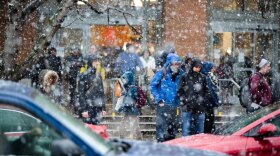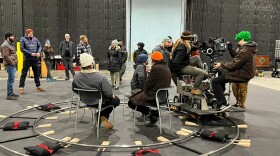Walk through the front door of the Victorian Gaches Mansion, home of the Pacific Northwest Quilt and Fiber Arts Museum in La Conner, and prepare to be overwhelmed by color. Originally set to close Sept. 1, the exhibit on the main floor by Fidalgo artist Julie Sevilla Drake, “Thirteen Ways of Looking,” proved so popular that it was extended to Oct. 6.
Drake was inspired by Wallace Stevens poem, “Thirteen Ways of Looking at a Blackbird.” A careful observer of nature, Drake transforms what she sees into brightly colored abstract designs with titles like “White Raven Steals Crayons.”
Drake’s works are one of the jewels in the current showcase of textile arts at this historic architectural marvel on South Second Street in downtown La Conner.

In a tour offered by Bellingham’s Stephanie Oppelaar, recently hired as outreach and education manager, the myriad offerings at this small but packed museum included a variety of embroidery, antique quilts, jewelry, needleworks, make-it-yourself kits, linens, aprons, kimonos and more.
An even more recent hire is Carla Funk, who came on board in July as executive director.
As the founder of the Ruth Funk Center for Textile Arts in Melbourne, Florida, Funk oversaw daily operations and created not only the exhibition schedule but programs that included guest artist lectures, demonstrations and workshops.
“Museum work has always appealed to me,” she said, “ because it is educational and intellectually stimulating, but more informal than a traditional academic setting.”

“I also like interacting with different age groups,” she added. “Museum programming reaches diverse age groups from children to senior citizens and are great places for lifelong learning.”
Challenging preconceptions
Funk hopes to bring more programs that “create joy” for visitors at the museum, including music at open houses; workshops in everything from basket weaving to knitting; and even fashion shows.
“I really think that textile art is much bigger than people realize,” she said. She wants to elicit not just surprise appreciation about the exhibits, but she aims to change preconceived notions about art.
Quilts and other fiber arts can be fun, she says, and because museums are a more relaxed way to see art, viewers can be emotionally drawn in, learn about various cultures, and even be politically challenged.
One of the upcoming exhibits she’s most excited about is “The Red Dress,” slated to open in January. “The Red Dress” was conceived in 2009 by British artist Kirstie Macleod as a way for women and girls from around the world to share their stories through embroidery. At first, the garment project was an artistic way to create a community of dialogue of personal storytelling, and now it’s a conduit to explore a means to portray marginalized voices and cultures.
“I’ve always been drawn to women’s history and the female aesthetic,” said Funk. “The Red Dress” is not only ornamental, she said, but it’s a way of telling stories that triumph from pain and overcoming struggle.
Remembering
Quilting has been seen as a traditional way for women to not only use the fabric scraps from sewing clothes but as a way to remember events. Bellingham quilters are doing just that.
Karen Harris said that her motivation besides saving the memories is the beauty of the fabric — the art and color. She’s been creating these memories since she was a teenager. For example, she said that when her father, a navigator in the Air Force died, she asked her mother for his much-loved plaid shirts and Harris made her a memory quilt of vintage airplanes flying through flannel clouds for her mother.
Ellen Pfiefer says “quilting is an art form that is practiced all over the world. It rewards the eye and the touch. There are innumerable styles and idioms.”
Pfiefer has visited the La Conner museum several times. “The wonderful Victorian building in which they are housed is delightful any time of year.,” she said. “It’s large enough to allow for several exhibits at once but not so large that the viewer is overwhelmed.”
Arlene Feld agrees that when she visited the museum, she “saw the range of materials, the creativity possible in the abstract exhibits.”

On exhibit through Oct.13 on the museum’s second floor is “Quilts Japan: The 16th Quilt Nihon,” one of the biggest quilting contests in Japan, which was conceived to promote patchwork and quilting. The intricacy and symbolism in these quilts demonstrate the skills of 36 accomplished artists.
The third floor holds a fascinating array of works by Oklahoma artist Kendall Ross, in “Finding a Moment.” The creative knitter incorporates non-cliche thoughts into her nonfunctional but stunning sweaters and other wearable art. Some of her stitches are amusing, some are thought-provoking, and some are meaningful in a personal sense, like “I have nothing to prove and no one to impress.”

Coming up Oct. 4–6 at the Edward G. Hansen Conference Center in Everett is the International Quilt and Fiber Arts Festival, hosted by the La Conner museum, which will feature lectures, workshops, exhibits, and vendors from around the world.
“The Pacific Northwest Quilt and Fiber Arts Museum is much more than quilts in a Victorian mansion,” said Funk. “The textile arts on display are beautiful to look at, but also tell fascinating stories about cultural identity, personal aspirations, technical discovery, and society.”
The Salish Current is a nonpartisan, nonprofit, online local news organization serving Whatcom, San Juan and Skagit counties by reporting local news with independence and strict journalistic integrity, and by providing fact-based information and a forum for civil commentary.






